Columbia 2019
TRVL 300: Cartagena, Colombia
Spring 2019
Travel dates: March 15-25, 2019
Culture and Identity in Latin America/Caribbean south America
Credits: 3

Trip Highlights
Students will immerse in Latin American culture and language through interesting activities such as:
- learn about Latin American colonial history on a bike tour through The Walled City (Cartagena’s Historical Center);
- explore ecological wonders in a boat trip to Isla Baru and hiking in the Tayrona National Park;
- learn about indigenous people’s values and ways of life in a visit Tayrona (Tairona) Ancient Civilization of the Sierra Nevada in Colombia;
- discover cultural treasures in the Casa Museo Arte y Cultura la Presentacion, and visit the house/museum of the best most prominent Latin American writer, and Nobel Prize winner, Gabriel García Márquez;
- explore popular culture while wondering through neighborhoods filled with street art, local artisans, and public markets;
- learn about early anti-slavery resistance, palenquera tongue (a mix of Spanish and African languages) and African legacy in the town of Palenque de San Basilio;
- dance to Afro-Caribbean rhythms, such cumbia, salsa, merengue, and Champeta; and
- enjoy Caribbean-Colombian food, a mix of Spanish, African, and native South American traditions.
I. Course Description:
This is a faculty-led travel course running from January-March long course with 10 days in Colombia’s Caribbean Coastal region.
During the course, we will examine significant notions and debates about Latin American cultural identity. Even though many of its nations share historical and political heritages, Latin America is defined by its ethic, racial and cultural heterogeneity and distinctive regional identities. We will focus on historical events and cultural productions from the colonial period to the present throughout the Spanish-speaking Caribbean South American. The structure of this course is primarily thematic but also chronological. The Caribbean South American is mostly known for civic-political unrest, such as Colombian violent civil conflict and and Venezuela’s radical socialist politics, nonetheless the region’s cultural resilience and non-western political philosophy remains overlooked. Students will engage with a variety of materials including Spanish chronicles, political manifests, letters, philosophical essays, literary works, and film. In addition, we will evaluate the ways that historical global influences and power relations, as well as an uninterrupted history of resistance and emancipation, have shaped Latin American cultural identity. Special attention will be given to the complexity of colonial legacies, nationalist projects, the rise of populism, and cultural globalization.
This travel course offers three components:
1) Non-travel. This component will function as any academic course, students will meet regularly on campus before and after travel segment, and will include a regular academic experience of reading, research, and writing.
2) Language instruction (optional). This component will provide students with Spanish language instruction at their particular level of competency
3) Travel. This component includes lectures as well as excursion trips that relate to the subject material and cultural understanding of the region. In Colombia we will visit:
- the walled city of Cartagena, a colonial major Spanish port founded in 1533, with more than four centuries of history and culture;
- Palenque de San Basilio, a town founded by escaped slaves as a refuge in the seventeenth century, this small village has become a unique cultural space, inhabited by the only community of palenqueros, who survived until the present day;
- the fishing village of Santa Marta, where we will enjoy a vibrant cultural scene in a unique geographical location at the foothills of the Sierra Nevada and on the Caribbean coast;
- Tayrona National Park, a large protected area known for its tropical rain forests, coastal lagoons, and abundant biodiversity; and
- the Pueblito Chairama, an archaeological site accessed through trails in the forests, with terraces and structures built by the Tayrona civilization.
II. Student Learner Outcomes
- Evaluate the ways that historical global influences have and continue to shape Latin American contemporary cultural identities.
- Examine socio-historical contexts in order to reflect upon South Caribbean Latin American lived experiences, thoughts, and visions.
- Engage in critical dialogue about issues of race, ethnicity, class, and gender as it pertains to the South Caribbean Latin America.
- Engage in critical assessment of political philosophies, social perspectives and practices, as well as cultural products addressed by the readings.
- Further the Spanish language literary and conversational competencies to successfully interact within a Spanish-speaking community.
- Apply and evaluate modes of academic inquiry, creative expression, and results of research problems regarding identity formation in the Caribbean South America.
Travel Itinerary March 15-25, 2018
Day 1 (3/15) Cartagena de Las Indias
Departure from Logan International Airport and arrive in Cartagena de Indias, Colombia.
Our hostel will be located in the Getsemaní neighborhood, which is close to the walled city. The atmosphere and the place are
very nice, as it is surrounded by bars, restaurants, and plazas. Student will share
rooms with AC. A delicious breakfast will be included.
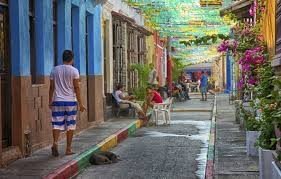
Our hostal in Getsemaní neighborhood
Day 2 (3/16) Colonial History of Cartagena de Indias. Historical Bike tour of the Old City
After breakfast, we will start the bike tour in the Getsemaní neighborhood and then visit some of the essential corners of Cartagena de Indias, its neighborhoods, and its port. We will observe examples of the military colonial architecture, such as the San Felipe Castle or the Portillo Fort.
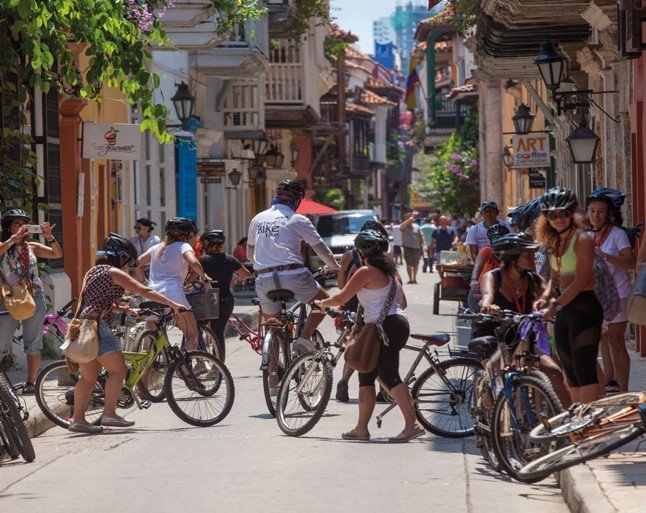
Bike tour
We will have the opportunity to see famous monuments, such as the sculpture of the old boots and the statue of the Indian Catherine, and many murals/street art along the way. Finally, the tour will take us through the streets of Getsemaní, the oldest neighborhood in Cartagena and the place where the independence of the city was declared.
After a heathy lunch in one of Cartagena’s the many comedores populares (community kitchens), we will tour San Felipe de Barajas Castle, the grandest fortress that Spaniards built in the mid-seventeenth century. We will explore most of castle including its sophisticated tunnels.
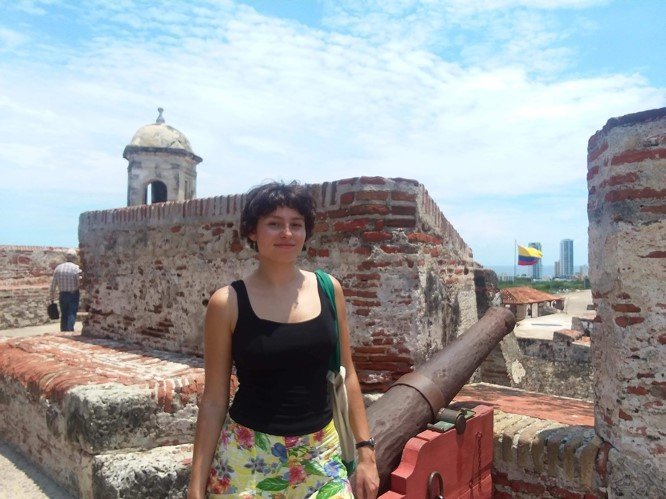
My daughter in San Felipe de Barajas Castle
For dinner, we will indulge in Colombia’s world famous street food!
Day 3 (3/17) History of Colonial Institutions
In the morning, we will tour the Convent Chapel of Mount Popa, an Augustinian monastery dating from 1610. The building was a strategic defensive enclave that suffered repeated attacks by pirates, including Francis Drake in 1585 and the English Navy. Years later, the convent was converted into barracks, where Simón Bolívar was one of its most famous guests.

View of Cartagena from La Popa Convent
After lunch, we will visit the Cloister of Santo Domingo, the oldest and one of the most beautiful churches in Cartagena. Inside we will find a Christ carved in wood from the 19th century and a Virgin which has a crown adorned with gold and emeralds. We will also visit the Cathedral of Cartagena and the Sanctuary of San Pedro Claver, a noted anti-slavery and revolutionary priest.
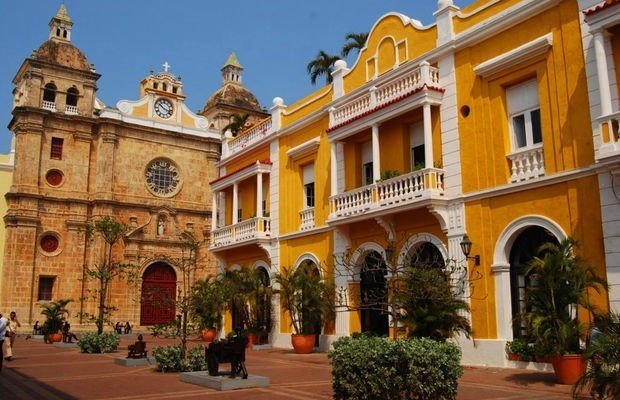
Sanctuary of San Pedro Claver
We will also visit the Palace of the Inquisition, one of the most important examples of institutional colonial power. This Baroque style house was a tribunal for the holy office to condemn anyone the Church saw as an enemy. It houses instruments of torture, along with documents, explanations, and paintings about the Inquisition.
We will end up our day with a visit to the El Museo del Zenú/Gold Museum, were we will learn about the Zenú people, its agricultural economy and cultural legacy. We will examine pre-Columbian pieces and gold jewelry making techniques.
Day 4 (3/18) Legacy of African slaves in Cartagena and San Basilio de Palenque
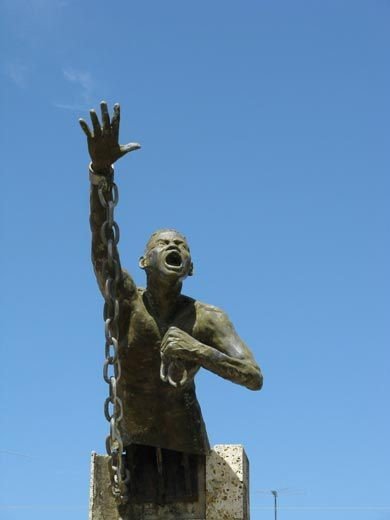
Benko Bioho, a African king who founded San Basilio de Palenque
From Cartagena, it will take us about 1.5 hours to travel to San Basilio de Palenque. We will visit the village and the cultural center, where we will learn about the history of Palenque, American first village founded by fugitive slaves. We will learn about Palenquero, a creole language, Afro-Columbian rhythms and dances, and enjoy a typical Palenque dish for lunch.
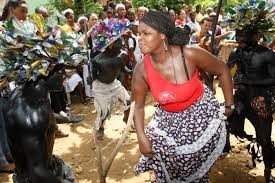
Dancing Palenqueras en San Basilio de Palenque
At our return to the old city Cartagena will have dinner at La Mulata, which offers a creative and delicious menu loyal to it's Caribbean roots.
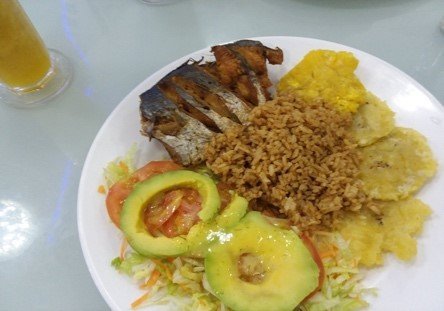
Fried fish, coconut rice fried plantains and avocado salad
Day 5 (3/19) Arts and Culture
In the morning we will go on a historical, cultural, and literary audio tour concerning the life and work of the notable Colombian writer, Gabriel Garcia Marquez.
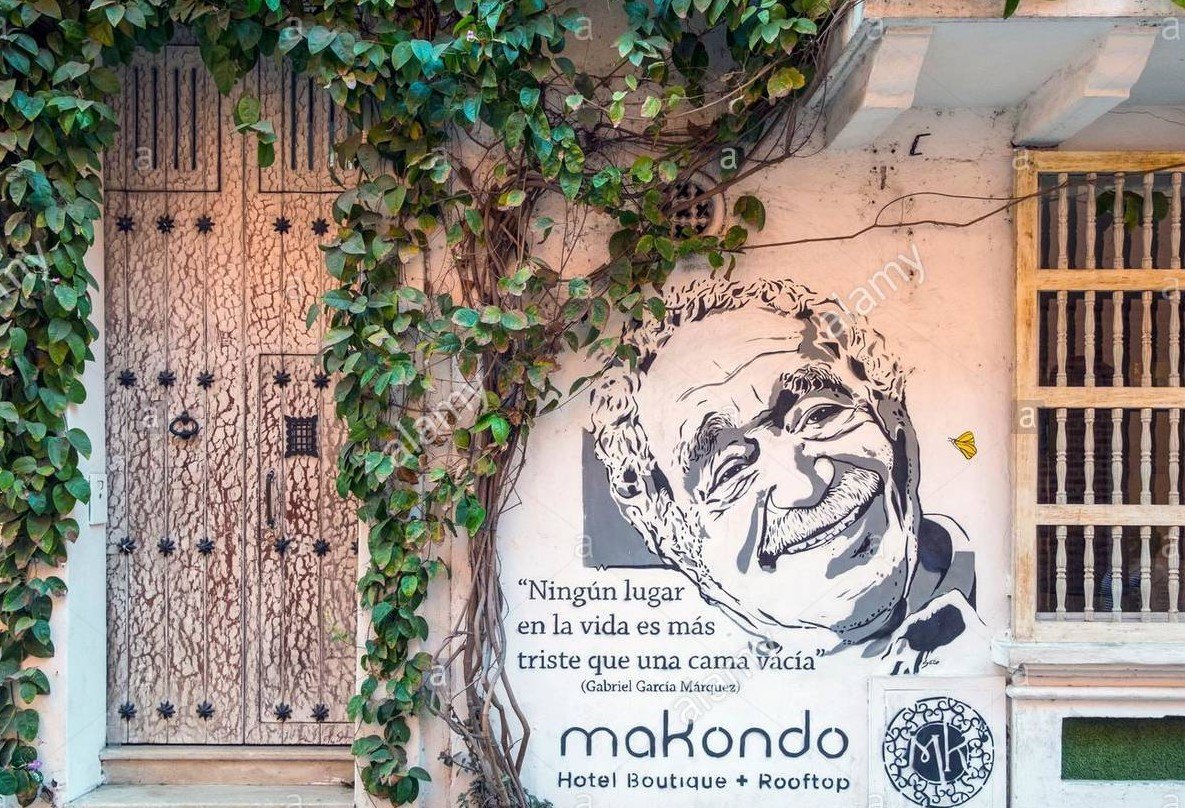
“Gabo" in a streel in Cartagena
We will discover the city's mysteries with a mixture of reality and fiction by evoking
the characters in his novel, Love in Times Cholera, that is set in Cartagena. After lunch, we will go for a Murals tour through the bohemian neighborhood of Getsemaní, one of the most beautiful open-air museums in this area of the Colombian Caribbean.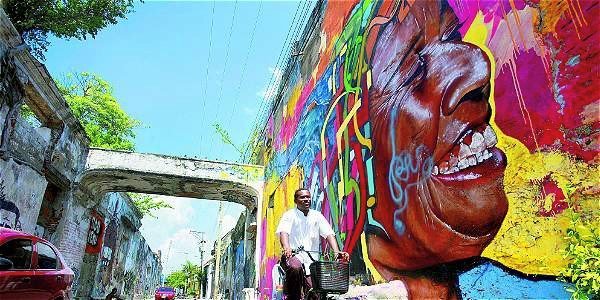
Barrio Getsemaní
We we will learn about characters like the poet Jorge Artel, the dancer Delia Zapata Olivella, the liberator of slaves Benko Bioho and the leader of the independence Pedro Romero, whose portraits were created by thirty artists during the International Festival of Urban Art in 2013.
In the afternoon will attend a cultural event at the University of Cartagena de Las Indias, the oldest in the Colombian Caribbean and founded in 1827 by Francisco de Paula Santander and Simón Bolívar. (To be announced)
Day 6 (3/20) The day-trip to Playa Blanca on Isla Baru
We will take a 45 minute boat ride from the Muelle Turistico de la Bodeguita, Cartagena’s old port, that will take us to Playa Blanca on Isla Baru.
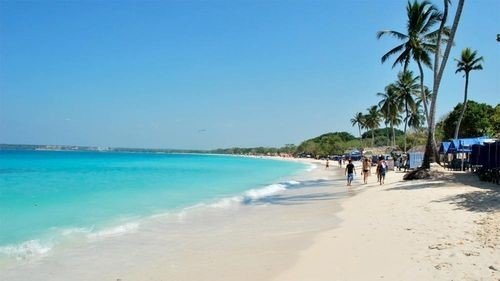
Playa Blanca on Isla Baru
The tour takes a scenic route through the Islas del Rosario, stopping at one of the islands where we will snorkel. After an hour spent watching tropical fish in their natural habitat, the tour will continue to Playa Blanca, a paradise of white-sand beaches and crystal-clear waters, where we will enjoy a lunch of Colombian specialties, and tropical fruit!
Back in Cartagena dinner will on your own. It is time for students to explore the Cartagena at night!
Day 7 (2/21) Food, Music and Dance!
Will have a typical regional breakfast at the Mercado de Bazurto. This market takes you out of the charming old city and into the depths of local life in Cartagena. The Bazurto market is gritty, rowdy and huge. It is filled with intriguing items and exotic Colombian ingredients not found in the supermarkets.

Mercado de Bazurto
Walking by the market stalls, we will learn about the essential ingredients to prepare Cartagenera’s food, such as shrimp with garlic, cheese mote, and empanada with egg. Students will have plenty of opportunities to practice their Spanish!
Music and Dance. Colombia share its musical influence with other Caribbean nations including salsa, merengue, and reggaeton. While the most popular local rhythms are the cumbia and vallenato, Champeta is a genre of music and dance native to Cartagena. Students will have a music history lecture followed by dance lessons at Crazy Salsa.
Day 8 (3/22) Santa Marta, Colombia
Visit the fishing village of Santa Marta, the oldest city in South America. The city has a unique architectural colonial heritage, and great cultural legacy, We will stay at a hostel in the historic center, an ideal location to explore the city. In Santa Marta we will tour the Quinta de San Pedro Alejandrino, a hacienda-museum, built in the seventeenth century, famous for being the place where Simón Bolívar died on December 17, 1830.
At dusk, we will head towards the Malecón de Bastidas, a beach boardwalk where we will find many stalls selling typical sweets, and delicious street food, as well as refreshments, indigenous crafts and the cheerful music of soloists and bands with Afro-Caribbean rhythms.
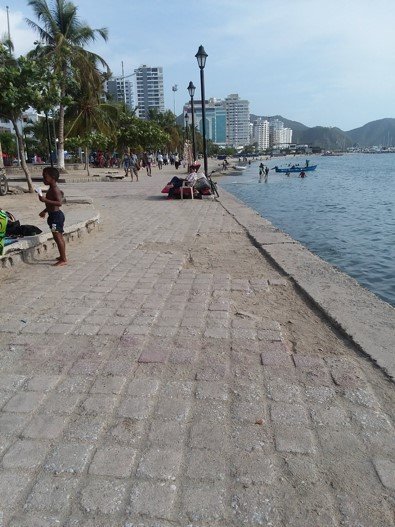
Malecón de Bastidas
Day 9 (3/23) Hike to Pueblito Chairama (Archaeological Center of the Sierra Nevada)
Departure from Santa Marta by car until we reach Tayrona National Park, is a paradise that offers wonderful beaches and it is also rich in history.
Once in Tayrona, we will walk along the beach and then follow the path through the jungle for 2-hours, until arriving to the archaeological zone of Pueblito Chayrama.
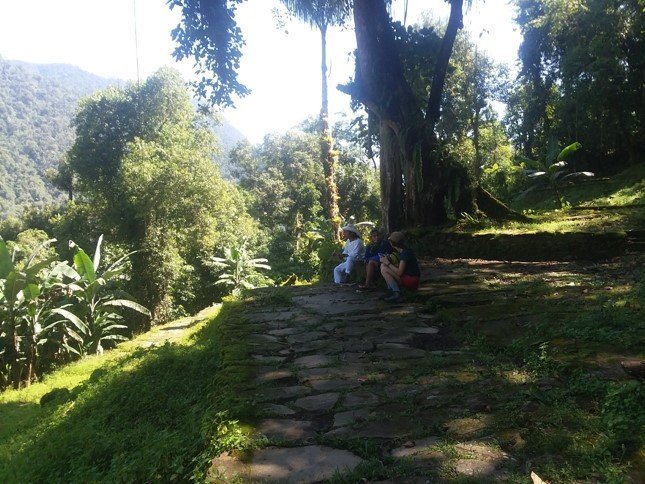
Pueblito Chayrama
This small village belonging to the Tayronas (indigenous community that resides in this part of Colombia) and it is part a complex of numerous villages and hamlets spread throughout the Sierra Madre region, forming a large network that supports trade and other businesses.
El Cabo San Juan, Tayrona National Park
After the hike, we will go to El Cabo San Juan, where we will enjoy the beautiful beaches, and have lunch. The tour continues to the natural swimming pool, and to Cañaveral, where the return to the city of Santa Marta.
At night we will have a traditional Colombian Cook party at the hotel’s terrace!

Our hostal in Santa Marta, Colombia
Day 10 (3/24) Return to Cartagena. Student will be own their own to explore the places
of interest
Day 11 (3/25) Early departure from Rafael Núñez International Airport.
Arrival to Logan International Airport, and van drive back to MCLA.
Travel Logistics
The trip total cost is $2,000, including the following:
- All air and ground transportation, including airfare Boston/Cartagena, bus fare Cartagena/Santa Marta and private van services Cartagena/San Basilio Palenque.
- All accommodations for 10 nights in funky and conveniently-located and hostel with 2- 4 students per room.
- Local guides, museum and park entrance fees.
- Boat trip to Isla Baru.
- All breakfasts are included with accommodations cost, most lunches are included with tours and most dinners will be provided.
- Travel health insurance
The cost of this trip will be paid in four installments between the end of September, 2018 and the end of January, 2019. Any cost saving will be provided to the students for their use during the trip. Two merit based scholarships of 542$ are available.
Learn more about this opportunity during an information meeting in Fall 2018, where we will cover:
- Syllabus including assignments and course objectives;
- Instructions for registration;
- Student's responsibilities while abroad - being conscious of the culture;
- Airfare purchase deadline/budgeted cost deadlines;
- Luggage limitation; and
- Insurance.
In the meantime, please contact Professor Bolívar if you have any questions at m.bolivar38@mcla.edu
Faculty leader
Mariana Bolívar Rubín received her Ph.D. in Hispanic American literature and cultures at the University of Colorado, Boulder. She is currently an Assistant Professor of Spanish at Massachusetts College of Liberal Arts. In her current project, she is examining the representation of Afro-Caribbean religion in Latinx literature and film. As a Venezuelan native, she is fluent in Spanish and conversant in Portuguese. She enjoys backpacking and solo travel, Her journeys in Centro American and South American include Venezuelan and Colombian Andes, High Mountain Ranges of Colombia’s Sierra Nevada, Central American Volcanic Arc in Nicaragua, southeast Mexican jungle (primarily Oaxaca, San Cristobal, Palenque and the Yucatan peninsula), Sierra Madre mountains in Central Mexico, and the many desert wonders of the American West.
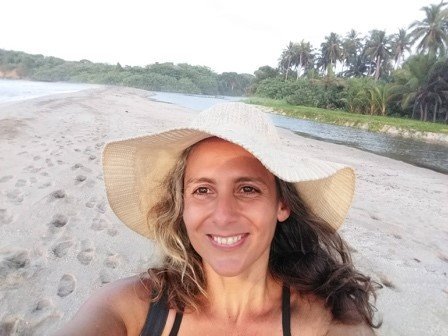
For more information, please contact:
Associate Professor of Modern Languages
Office: 100 Porter #4
Office hours: MWF 11-12pm and by appointment
Office phone number: 413-662 5081
m.bolivar@mcla.edu
